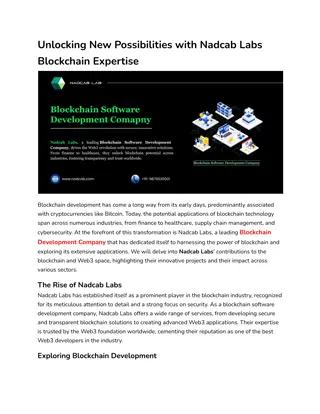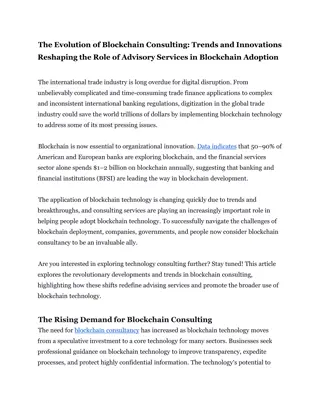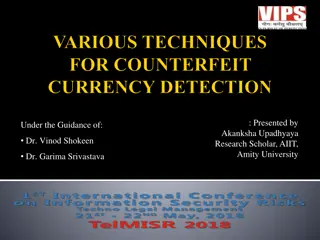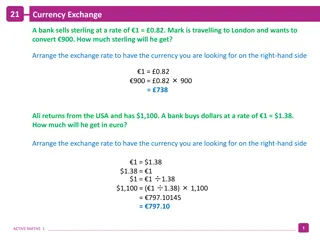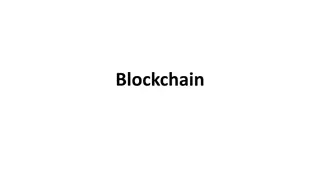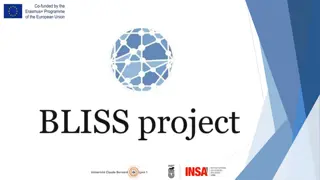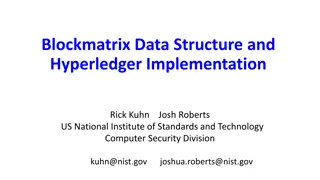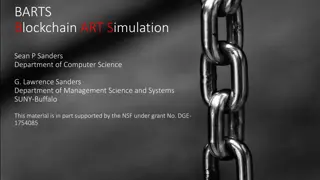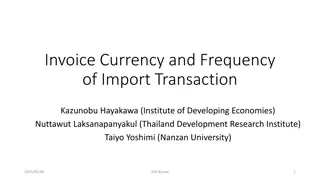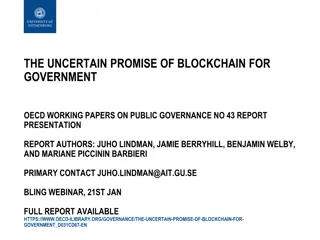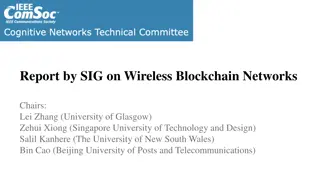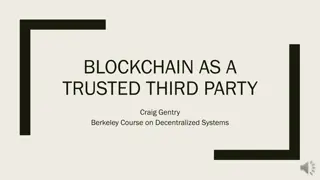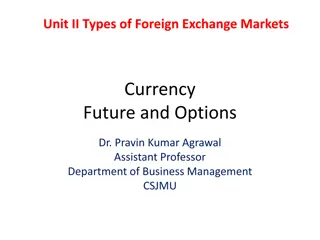Exploring Digital Currency and Blockchain Technology
Delve into the world of digital currency and blockchain technology, from the inception of DigiCash to the concept of digital work measured through hashing. Discover the potential of all-digital currency and the importance of work verification in the blockchain ecosystem.
Download Presentation

Please find below an Image/Link to download the presentation.
The content on the website is provided AS IS for your information and personal use only. It may not be sold, licensed, or shared on other websites without obtaining consent from the author. Download presentation by click this link. If you encounter any issues during the download, it is possible that the publisher has removed the file from their server.
E N D
Presentation Transcript
Blockchain Blockchain
Digital Cash is not New DigiCash Inc., founded in 1989 o Based on Chaum s blind signatures o Strong crypto that ensures anonymity Back then, the killer app was thought to be micropayments o Users on the Internet pay only a tiny amount (fraction of cent) for something DigiCash declared bankruptcy in 1998 Blockchain
Digital Currency We want create an all-digital currency o Like $ or or or ., but better Real cash is (relatively) anonymous o So digital currency should be too Digital currency is better since o No central authority (i.e., banks) o No government to issue currency, etc. Blockchain
Preliminaries: Work How to measure (digital) work ? Our unit of work will be 1 hash Suppose that we have a hash function h(x) that generates an N-bit output Then randomly chosen input generates one of 2N equally likely outputs o For any input R, have, 0 h(R) < 2N o Different R yield uncorrelated hashes Blockchain
Hashing to Prove Work Suppose we have a 16-bit hash function For any R, we have 0 h(R) < 65,536 If we want R so that h(R) < 64, then how many R values do we need to hash? Since h(R) = y = (y15y14y13y12y11y10y9y8y7y6y5y4y3y2y1y0) we want output like (10 leading 0s) h(R) = y = (0000000000y5y4y3y2y1y0) Blockchain
Work and Hashing For 16-bit hash, how many hashes until h(R) = y = (0000000000y5y4y3y2y1y0) ? For random R, we have a 1/2 chance that y = (0y14y13y12y11y10y9y8y7y6y5y4y3y2y1y0) And 1/4 chance that y = (00y13y12y11y10y9y8y7y6y5y4y3y2y1y0) And 1/8 chance that y = (000y12y11y10y9y8y7y6y5y4y3y2y1y0) And so on Blockchain
Work and Hashing For 16-bit hash, if someone gives us an R such that h(R) < 64 o Then expected number of hashes computed is 210( expected means average case) o That is, they have done 1,000 units of work We use hashing to show work was done Why this obsession with work? o That will become clear later Blockchain
Work and Hashing We can adjust parameter so more work (or less) is required o For N-bit hash, if we require h(R) < 2n then expected work is 2N-n hashes Note: We can easily verify that the expected amount of work was done o Only requires one single hash o No matter how much work to find R Blockchain
Preliminaries: Ledgers Ledger is a book of financial accounts Suppose Alice, Bob, Charlie, Trudy play weekly poker game online They all insert ledger entries such as, Bob owes Alice $10 , Charlie owes Trudy $30 , Trudy owes Alice $25 , and so on Once a month, they meet and settle up Any possible problems here? Blockchain
Signed Ledger Entries How to prevent Trudy from inserting, say, Bob owes Trudy $1M ? So, let s require digital signatures o For ledger entry to be valid, Bob must sign Bob owes Alice $10 , Trudy must sign Trudy owes Alice $25 , and so on Then we know ledger entries are valid o That is, the payer agrees to pay Blockchain
Signed Ledger Ledger now looks like o [Bob owes Alice $10]Bob o [Charlie owes Trudy $30]Charlie o [Trudy owes Alice $25]Trudy o and so on And we know ledger entries are valid But, still some problems here Blockchain
Signed Ledger in Detail As an aside, note that signatures on previous slide really look like o (M1,[h(M1)]Bob), where M1= Bob owes Alice $10 o (M2,[h(M2)]Charlie), M2= Charlie owes Trudy $30 o (M3,[h(M3)]Trudy), M3= Trudy owes Alice $25 o And so on We ll use the shorthand on previous slide Blockchain
Ledger Duplication Still, nothing to prevent Trudy from duplicating a line o [Bob owes Alice $10]Bob o [Charlie owes Trudy $30]Charlie o [Trudy owes Alice $25]Trudy o [Charlie owes Trudy $30]Charlie Signatures are still all valid How to prevent this attack? Blockchain
Unique Ledger Entries Include unique transaction numbers o [1, Bob owes Alice $10]Bob o [2, Charlie owes Trudy $30]Charlie o [3, Trudy owes Alice $25]Trudy o And so on Why does this help? We will never have an exact duplicate o So any duplicate is invalid Blockchain
Ledger Prepayment How to be sure participants pay up? Can start with Alice, Bob, Charlie, and Trudy all putting money into the pot And don t allow any transaction that would result in negative balance Transaction must still be signed and now,nobody can overdraw account Blockchain
Ledger Prepayment Example Ledger example o Alice has $100 // Alice s initial stake o Bob has $100 // Bob s intial stake o Charlie has $100 // Charlie s initial stake o Trudy has $100 // Trudy s initial stake o [1, Bob owes Alice $10]Bob//valid o [2, Charlie owes Trudy $30]Charlie//valid o [3, Trudy owes Alice $25]Trudy//valid o [4, Trudy owes Bob $120]Trudy//invalid Blockchain
Ledger Prepayment Note that we must know the entire transaction history o So that we can know current balances o Then we can be sure a given transaction does not cause user to be overdrawn This seems like kind of a hassle, but some big benefits come from it o As we will soon see... Blockchain
Eternal Ledger? Alice, Bob, Charlie, and Trudy could continue to settle accounts each month But, as the ledger currently stands, settling accounts is not necessary! We know the current balances, and no risk of anyone being overdrawn So, could play poker for months, years, or forever, without settling accounts Blockchain
Ledger as Currency This ledger can act as its own currency! o Need a cool symbol, let s use Transactions within ledger are all in terms of the currency Anyone can exchange ledger currency (i.e., ) for $ or or or o But, such exchanges occur outside the ledger currency protocol Blockchain
Ledger Currency For example, Alice could pay Bob $10 in real world dollars for, say, 5 of currency in the ledger system Comparable to exchanging, say, $ for The ledger is a history of transactions within the ledger currency system In fact, the ledger is the currency o This is the key insight for cryptocurrency Blockchain
Distributed Ledger The ledger is the currency o So who is in charge of the ledger? o A govt? The UN? A bank? An individual? We don t trust them, so let s put everybody in charge of the ledger o Anybody can have copy of ledger, anyone can add entries (there is a protocol ) o Protocol without a central authority! What problem(s) do you foresee? Blockchain
Distributed Ledger 1. Transactions must be signed 2. Nobody can be overdrawn 3. Transactions broadcast to everybody o How to have a consistent view of this distributed ledger? o Multiple ledgers can exist at any time o This is the heart of the issue for a distributed cryptocurrency (e.g. Bitcoin) Blockchain
Distributed Ledger and Work Every ledger will have some amount of work associated with it Ledger with most work always wins o That is, everyone accepts ledger that has the most work put into it Recall, work is measured in hashes So, more hashes is more better Blockchain
Blocks and Hashes Each transaction is signed Transactions grouped into blocks o Let B be one such block Find (nonce) R so that h(B,R) < 2n o Equivalent to saying h(B,R) starts with a specified number of 0s Work required to find R? o On average 2N-nhashes for N-bit hash Blockchain
Chain Don t want to revalidate each block, want to order blocks, and so on We ll chain blocks together o Put hash of previous block in header of current block before computing hash So, must find R so that h(Y,B,R) < 2n o Where Y is hash of previous block Blockchain
Blockchain We now have Yi+1 = h(Yi,Bi,Ri) < 2n Yi+2 = h(Yi+1,Bi+1,Ri+1) < 2n Yi+3 = h(Yi+2,Bi+2,Ri+2) < 2n Each B is a block o Block is a group of signed transactions Each R is chosen so inequality holds o Lot of work to find R, easy to verify Y< 2n Blockchain
Mining? Anyone can create a new block But lots of work to find a valid hash So what is the incentive to do work? Free money! o Get (new) money for doing work, say, 1 o Put this info at start of block, does not need to be signed (since new money) Blockchain
One Block Block Bi looks like Blockchain
Mining Free money, so miners are in a race to find hashes that yield valid blocks The more computing power a miner has, the better chance to win race Once a valid hash is found, miner sends the block out to everybody Again, easy to verify hash is correct Blockchain
Blockchain Blockchain looks like Require that h(Yi,Bi,Ri) < 2nand so on Blockchain
Mining Why is mining called mining ? o Really, just finding a valid block hash Miner is doing work, and creating new money that did not previously exist o In a sense, this is comparable to mining gold or silver (for example) This may be the most misunderstood part of cryptocurrency protocols Blockchain
Non-Miners Users do not have to be miners Non-miner just wants blockchain o Needed to know how much others have Also, non-miner sends out transactions for others to make blocks (and mine) User might see conflicting blockchains o What to do in such cases??? More work is more better ! Blockchain
More Work If conflicting blockchains, how to know which represents more work? Each block is a fixed amount of work o In terms of expected number of hashes So, longer block chain is more work Thus, longer block chain always wins o If it s a tie, wait until one is longer Blockchain
Summary of Protocol New transactions broadcast 1. 2. Miners collect transactions into blocks 3. Miners race to find valid block hash 4. When miner finds hash, broadcast it 5. Block accepted if all transactions signed, no overdraft, & block hash valid 6. New block extends the blockchain o Miners use hash of new block in next block Blockchain
Attack Scenario Suppose Trudy makes a block Bthat includes transaction o [Trudy pays Alice 100]Trudy o Trudy sends B to Alice only, nobody else Q: Why would Trudy do this? A: So she can spend that 100 again o Trudy likes double spending! o It s free money! Blockchain
Double Spending For Trudy s double spending attack to work, she must compute valid hash o That is, find R, so that h(Y,B,R) < 2n And send chain with block B to Alice But, nobody else knows about B, or the chain that contains it o All other miners working on other chains o Those other chains can (and will) grow o Trudy is in a race with all other miners Blockchain
Double Spending Attack Assuming she waits, Alice will reject Trudy s chain if longer chain appears Trudy would need majority of compute power in network to win consistently o Trudy needs to win a lot! Or, miners must collude with Trudy o But is it in their interest to do so? Blockchain
Blockchain From users perspective o Transaction in last block might not be entirely trustworthy o Possibility of double spending attack o But, the more blocks that follow, the more certain that a transaction is valid Just wait until a few more blocks are added before accepting a transaction Blockchain
Refinements Number of hashes can change so that winning hash takes constant time o Computing power in network can increase o In Bitcoin, new block every 10 minutes Can decrease mining reward so money supply does not grow forever o E.g., maximum of 21,000,000 bitcoins o Then what will be incentive for miners? Blockchain
Refinements Merkle tree can be used to reduce storage requirements o Transactions in a block hashed in a tree, only the root is needed in block hash Simplified payment verification o In effect, rely on others to verify for you Combining and splitting value o Transaction can have multiple input/output Blockchain
Privacy? Can use pseudonym in public key But, can still connect transactions to a specific public key o Might be able to tie public key to an individual based on transactions o We ll see examples like this later Not a super-strong form of anonymity Bitcoin is said to be pseudonymous Blockchain
Future of Blockchain? Blockchain can be viewed as a way to implement a distributed ledger Useful for cryptocurrency, but many other possible applications too Blockchain said to be a foundational and/or disruptive technology Perhaps, but your skeptical author is not completely convinced Blockchain
References Excellent video: https://www.youtube.com/watch?v=b BC-nXj3Ng4 Original bitcoin paper (surprisingly easy to read): Bitcoin: A peer-to-peer electronic cash system, Satoshi Nakamoto, https://bitcoin.org/bitcoin.pdf Blockchain



